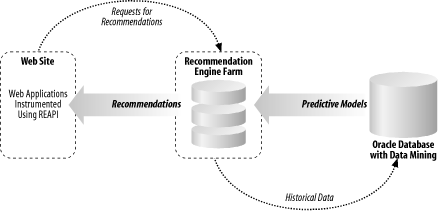12.3 Data Mining
| Data mining , as we define it in this chapter, is the use of mathematical algorithms to model relationships in the data that solve difficult problems involving large numbers of variables with unknown relationships. You might need such techniques if you are trying to solve such business problems as fraud detection, customer churn analysis, and marketing contact response prediction. The algorithms used to solve such problems include clustering techniques that show how business outcomes can fall within certain groups (such as for market basket analysis) and logic models (if A occurs, then B or C are possible outcomes ), validated against small sample sets and then applied to larger data sets for prediction. Since the Oracle9 i database release, Oracle has provided a set of data mining algorithms in the database's Data Mining Option for solving such problems. Algorithms now embedded in the database include:
These algorithms are accessible via a Java API. Data mining applications can be custom-built using Oracle's JDeveloper in combination with the Data Mining for Java interface. DM4J is used to develop, test, and score the models. It provides the ability to define metadata, tune the generated Java code, view generated XML files, and test application components . The J2EE-generated applications can be deployed within the database, to Oracle Application Server, or to other J2EE platforms. OracleAS Personalization is one application of data mining that is bundled with Oracle Application Server. It provides the tools necessary to instrument a web site, gather data on how a web-site visitor traverses the site, and then use the data gathered to provide a "personalized" web experience by presenting specific pages that are determined to be of likely interest to the visitor. This solution is implemented in three tiers, as shown in Figure 12-5. The Recommendation Engine API (REAPI) is a set of Java classes that are integrated into the web application on the web site, enabling the gathering of needed data and specific actions based on recommendations from the middle tier. The data that is gathered as a web-site visitor traverses the site is captured and sent to an Oracle database installed with the data mining algorithms. There, scoring takes place to create a sorted, ordered list that is then applied to the middle- tier Recommendation Engine. That engine services the web site in real time, providing recommendations based on similar, previously analyzed trends. Figure 12-5. OracleAS Personalization architecture An OracleAS Personalization Administration User Interface (OPUI) accesses the Mining Object Repository (MOR) in the backend. The MOR schema contains business model information and is used for configuration and report administration. A Mining Table Repository (MTR) contains the basic schema needed to create the model of the business, also referred to as a taxonomy . |
EAN: 2147483647
Pages: 120